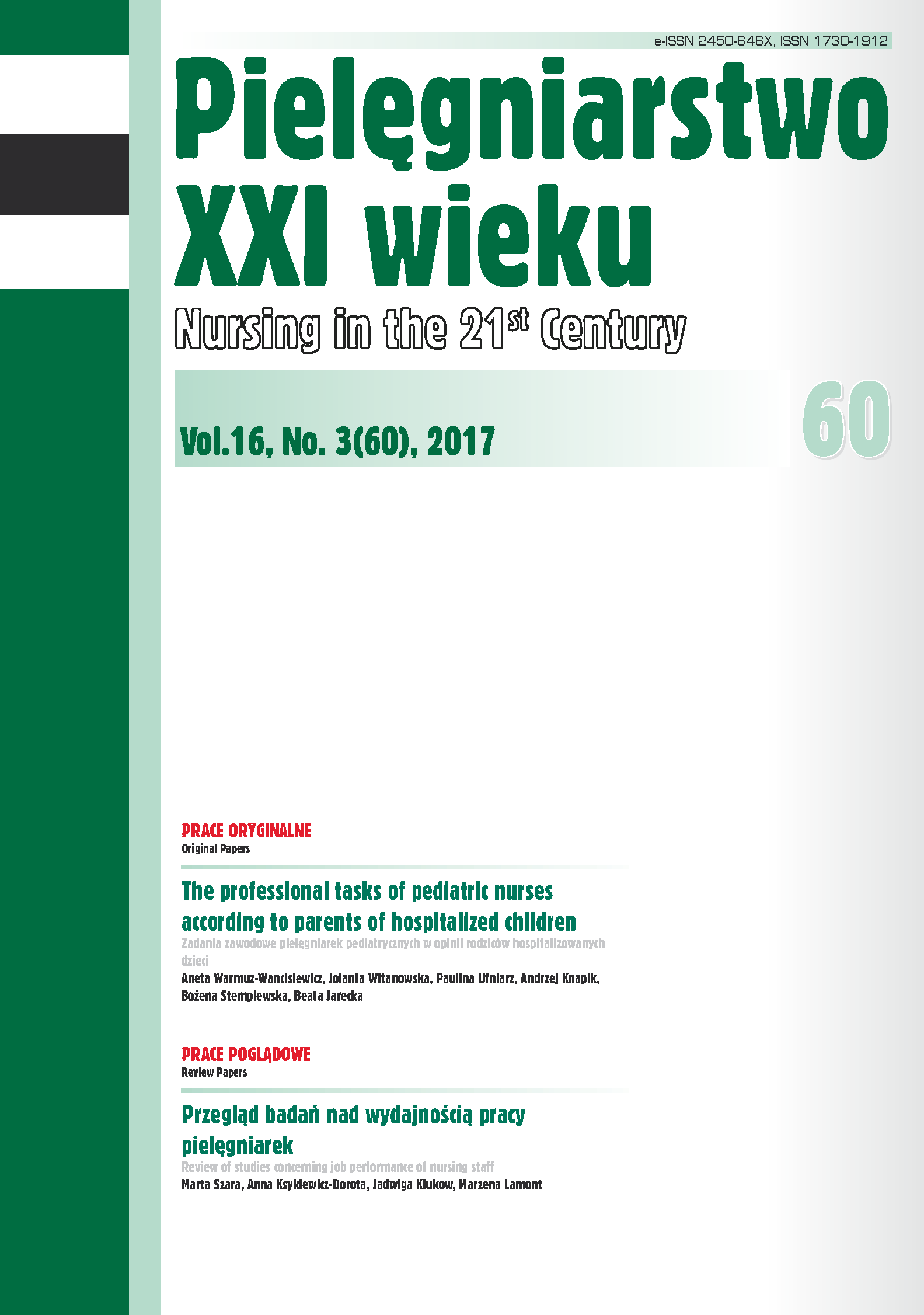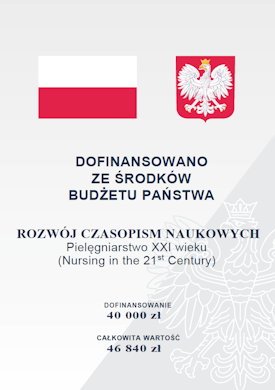Wpływ stosowania okołoporodowej profilaktycznej antybiotykoterapii na występowanie zakażeń wczesno-objawowych u noworodków
DOI:
https://doi.org/10.1515/pielxxiw-2017-0024Słowa kluczowe:
nosicielstwo GBS, zakażenie, poród, antybiotykoterapiaAbstrakt
WPŁYW STOSOWANIA OKOŁOPORODOWEJ PROFILAKTYCZNEJ ANTYBIOTYKOTERAPII NA WYSTĘPOWANIE ZAKAŻEŃ WCZESNO-OBJAWOWYCH U NOWORODKÓW
Cel pracy. Celem pracy była ocena skuteczności profilaktycznej okołoporodowej antybiotykoterapii na występowanie wczesno-objawowych zakażeń.
Materiały i metodyka. Materiał do badań stanowiły uzyskane z historii chorób dane 1328 żywo urodzonych, pojedynczych noworodków i ich matek. Badane parametry ciągłe opisano podając liczebność, średnią arytmetyczną, odchylenie standardowe, medianę oraz najmniejszą i największą wartość. Do analizy frakcji użyto testu Chi kwadrat; także z poprawką Yatesa (dla małych liczebności komórek). Poziom istotności statystycznej przyjęto dla p<0,05.
Wyniki. U 6,62% noworodków wystąpiło zakażenie wczesno-objawowe. Infekcję GBS stwierdzono u 14 z nich, lecz tylko u 5 z nich wyizolowano wyłącznie GBS. E. coli stwierdzono u 33 noworodków, a „inne bakterie”, w tym Enterococcus faecalis, Enterobacteriaceae, Staphylococcus epidermidis, Staphylococcus aureus wyizolowano od 42 noworodków. U 24 noworodków występowały objawy kliniczne zakażenia oraz dodatnie wskaźniki stanu zapalnego w badaniach laboratoryjnych, przy ujemnych wynikach posiewów bakteriologicznych.
Wnioski. W związku z wprowadzeniem obowiązku wykonywania badań w kierunku GBS ilość stosowanej antybiotykoterapii wzrasta. Skuteczność śródporodowej antybiotykoterapii oraz jest powszechność wydają się być zadowalające. Kolor wód płodowych może mieć wpływ na występowanie infekcji wewnątrzmacicznej, w tym wczesnoobjawowego zakażenia GBS.
Bibliografia
1. Al-Taiar A, Hammoud MS, Thalib L et al. Pattern and etiology of culture proven early-onset neonatal sepsis: a five-year prospective study. Int J Infect Dis. 2011; 15: 631-634.
2. Karthikeyan G, Premkumar K. Neonatal sepsis: Staphylococcus aureus as the predominant pathogen. Indian J Pediatr. 2001; 68: 715-717.
3. Meizoso T, Rivera T, Fernandez-Acenero MJ, et al. Intrauterine candidiasis: report of four cases. Arch Gynecol Obstet. 2008; 102: 480-485.
4. Tsai CH, Chen YY, Wang KG, et al. Characteristics of early-onset neonatal sepsis caused by Escherichia coli. Taiwan. J Obstet Gynecol. 2012; 51: 26-30.
5. Kotarski J, Heczko PB, Lauterbach R, i wsp. Rekomendacje Polskiego Towarzystwa Ginekologicznego dotyczące wykrywania nosicielstwa paciorkowców grupy B (GBS) u kobiet w ciąży i zapobiegania zakażeniom u noworodków. Ginekol Pol. 2008; 79: 221-223.
6. Centers for Disease Control and Prevention (CDC). Perinatal group B streptococcal disease after universal screening recommendations-United States, 2003-2005. MMWR. 2007; 56: 701-705.
7. Centers for Disease Control and Prevention (CDC). Trends in perinatal group B streptococcal disease-United States, 2000-2006. MMWR. 2009; 58: 109-12.
8. Goins WP, Talbot TR, Schaner W et al. Adherence to perinatal group B streptococcal prevention guidelines. Obstet Gynecol. 2010; 115: 1217-1224.
9. Picard FJ, Bergeron MG. Laboratory detection of group B Streptococcus for prevention of perinatal disease. Eur J Clin Microbiol Infect Dis. 2004; 23: 665-671.
10. Schrag S, Gorwitz R, Fultz-Butts K et al. Prevention of perinatal group B streptococcal disease. Revised guidelines from CDC. MMWR Recomm Rep. 2002; 51: 1-22.
11. Verani JR, McGee L, Schrag SJ. Division of Bacterial Diseases, National Center for Immunization and Respiratory Diseases, Centers for Disease Control and Prevention (CDC): Prevention of perinatal group B streptococcal disease - revised guidelines from CDC, 2010. MMWR Recomm Rep. 2010; 59, 1-36.
12. Dobrowolska-Redo A, Romejko-Wolniewicz E, Zaręba-Szczudlik J, et al. Porównanie przebiegu porodu, wczesnego połogu i okresu noworodkowego w zależności od flory bakteryjnej obecnej w wymazie z dróg rodnych. Perin Neonat i Ginekol. 2013; 6: 73-80.
13. Baker CJ, Barrett FF. Transmission of group B streptococci among parturient women and their neonates. J Pediatr. 1973; 83: 919-925.
14. Barton LL, Feigin RD, Lins R. Group B beta hemolytic streptococcal meningitis in infants. J Pediatr. 1973; 82: 719-723.
15. Boyer KM, Gotoff SP. Prevention of early-onset neonatal group B streptococcal disease with selective intrapartum chemoprophylaxis. N Engl J Med. 1986; 314: 1665-1669.
16. Glasgow TS, Speakman M, Firth S et al. Clinical and economic outcomes for term infants associated with increasing administration of antibiotics to their mothers. Pediatr Perinat Epidemiol. 2007; 21: 338-346.
17. Valkenburg-van den Berg AW, Houtman-Roelofsen RL, Oostvogel PM, et al. Timing of group B streptococcus screening in pregnancy: a systematic review. Gynecol Obstet Invest 2010; 69: 174-183.
18. Berardi A, Lugli L, Baronciani D, et al. GBS Prevention Working Group of Emilia-Romagna. Group B Streptococcus early-onset disease in Emilia-Romagna: review after introduction of a screening-based approach. Pediatr Infect Dis J. 2010; 29: 115-121.
Opublikowane
Numer
Dział
Licencja
Prawa autorskie (c) 2017 Autorzy

Praca jest udostępniana na licencji Creative Commons Attribution-NonCommercial-NoDerivatives 3.0 Unported License.




